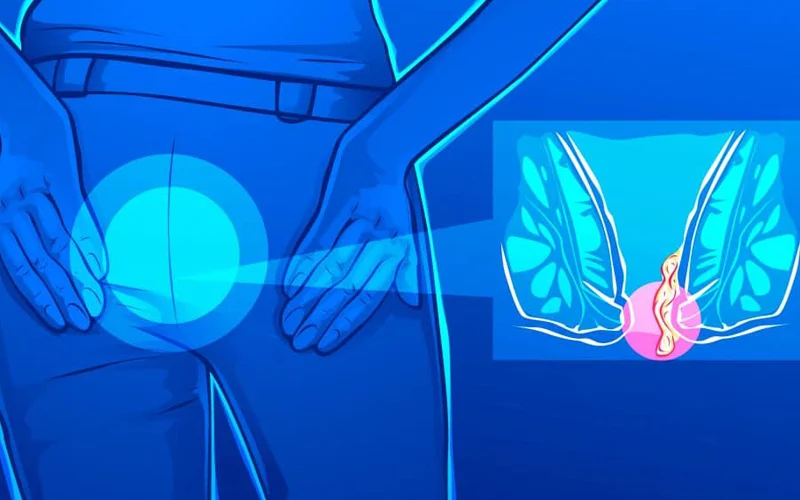Hemorrhoids (Piles), are swollen and inflamed veins that appear at the anus or inside the rectum in the lower part of it.
It can be external, where these veins are wrapped around the anus under the skin.
It can also be internal and appear in the lower part of the rectum or be in the lining of the anus.
Through the following paragraphs, we will discuss everything related to external hemorrhoids in females including causes, symptoms, and treatment methods in detail.
External Hemorrhoids in Females
External hemorrhoids are usually caused by straining, as some people have to sit on the toilet for long periods.
Or they have to push the stool forcefully due to constipation.
Hemorrhoids can develop, causing a clot at the cite of their appearance, causing severe pain for the patient, especially during the defecation process.
Pregnant women also could suffer from the problem of hemorrhoids as a result of the pressure of the fetus on the lower part of the abdomen and the digestive system, and as a result of constipation.
Hemorrhoids can cause itching and bleeding, and they may respond to home treatments such as warm baths, cold compresses, and other traditional methods.
In some cases, the doctor may be forced to perform a surgical procedure to get rid of the problem. (Lawrence & McLaren., 2023)
How Long Does It Take for a Hemorrhoid to Shrink?
In most cases, hemorrhoids can disappear on their own within a few days.
Or by taking some simple measures, such as drinking plenty of fluids.
Or eating foods rich in fiber, such as leafy vegetables and whole grains.
But in some cases, external hemorrhoids in females can cause serious complications, such as a microbial infection, a blood clot, or a massive hemorrhage that results in anemia.
In these cases, urgent medical intervention is required.
People Most Susceptible to Hemorrhoids
Every person is susceptible to hemorrhoids, and they may appear in adolescence.
However, it does not appear in children because it takes some time to develop.
The people most at risk of developing the problem are:
- People who follow a low-fiber diet.
- Pregnant women
- People with obesity.
- Those who suffer from chronic diarrhea.
- Suffering from chronic constipation.
- People who have to carry heavy things.
- People who spend a long time on the toilet bowl.
- Women in menopause are more susceptible to hemorrhoids due to the weakening and stretching of the tissues at the anus, which allows the blood vessels to expand and swell.
Symptoms of External Hemorrhoids in Females
Internal hemorrhoids in men and women, usually do not cause any symptoms.
But its symptoms begin to appear after the hemorrhoids prolapse.
However, it can cause bleeding, as the patient notices its presence in the toilet paper or in the stool, and this is a symptom of rectal bleeding.
Symptoms of external hemorrhoids in females include:
- The presence of external hard itchy lumps on the anus.
- Feeling of inflammation.
- Feeling pain in the area of hemorrhoids, especially when sitting.
- Rectal bleeding.
Prolapsed hemorrhoids are painful and uncomfortable, the patient can feel it and push it inside.
Diagnosis of Hemorrhoids
Hemorrhoids can sometimes resemble serious digestive problems, such as:
- Crohn’s disease
- Ulcerative colitis
- Colon cancer.
Therefore, the disease must be diagnosed correctly by doing the following:
- Physical examination:diagnosis of hemorrhoids is done by knowing the symptoms and physical examination of the patient by the treating physician.
- Digital rectal exam:The treating physician feels the swollen veins.
- Anoscopy:It is a lighted scope that clearly shows the anus and rectum.
- Sigmoidoscopy:an endoscope equipped with a camera to examine and photograph the lining of the rectum and anus. There are two types of it: the rigid type and the flexible type.
Although all these procedures seem uncomfortable, they are performed without anesthesia and the patient can go home the same day. ( Mott, Latimer , & Edwards, 2018)
What Is the Best Prescription Medicine for Hemorrhoids?
Mild cases of hemorrhoids do not require prescription treatment.
Some creams, ointments, wipes, or other medications can be used to help the patient by causing swollen blood vessels to constrict, relieving swelling, treating pain, and stopping bleeding.
These medications include creams that contain the compound phenylephrine.
Other medications that help treat hemorrhoids include:
- Local anesthetic such as Lidocaine, which provides the patient with a feeling of comfort and prevents pain and itching.
- Some vasoconstrictive medications such as witch hazel and zinc oxide
- Corticosteroids.
Hemorrhoids Treatment Medications
External hemorrhoids in females treatment medications are available in the following forms:
Suppositories: These are medications that are inserted into the body through the anus. They contain compounds that reduce the size of swollen veins, soften the tissues surrounding the anus and prevent constipation.
Wet wipes: They reduce the degree of friction between swollen veins and dry wipes, providing a more comfortable feeling.
Pain relief: Another method used to treat hemorrhoids, but although it helps reduce pain, it does not cure the problem.
Itch relief: To relieve annoying itching, creams containing corticosteroids can be used.
Another treatment that can relieve the itching feeling is
Witch hazel, which can be placed on a wet cotton and wiped off the itchy areas.
Surgical procedures: Among them is injection into hemorrhoid, where the blood supply to the enlarged veins is cut off and they end, and there is also Rubber band ligation, which prevents blood from flowing freely into the enlarged veins.
Best Ointment for Hemorrhoids
The best ointments for treating hemorrhoids are:
Hydrocortisone: To treat inflammation, reduce swelling, and get rid of itching.
Lidocaine, Pramoxine and Benzocaine: all work as a local anesthetic that gives a feeling of coolness and prevents pain and itching.
Witch hazel: a remedy that shrinks swollen blood vessels and reduces itching and pain.
Fastest Way to Get Rid of Hemorrhoids During Pregnancy
Hemorrhoids are a common health problem during pregnancy, as the fetus puts pressure on the veins in the lower part of the body and causes them to swell.
To improve symptoms, you can do the following:
- Sitting in a bath of warm water without soap or any additives.
- Avoid sitting for long periods, and when sitting you can use a hemorrhoid pillow.
- You can use topical ointments that contain witch hazel.
- Eat foods high in fiber content to avoid constipation.
- Drink plenty of water.
- In cases of severe constipation, use a natural laxative after consulting your doctor.
Read Also: What Are the Top 10 Symptoms of High Blood Pressure?
References
Mott, T., Latimer , K., & Edwards, C. (2018). Hemorrhoids: Diagnosis and Treatment Options. PubMed.
Lawrence, A., & McLaren., E. R. (2023). External Hemorrhoid. National Library of Medicine.

